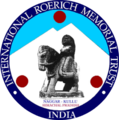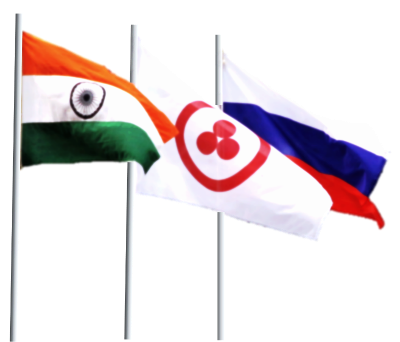21.08.2013
Agreement between the International Centre of the Roerichs, Moscow, and the International Roerich Memorial Trust, Naggar, India – one more step towards realization of the Roerichs’ dream of rapprochement between India and Russia




It is necessary to plan a number of comprehensive steps to create this Memorial Museum complex in the Roerich Estate. For the time being the Russian experts are busy making a proper record of collections and museum items at the IRMT in accordance with international museum standards. We started to fill up the main Record Book which was made in Moscow on the special order of the ICR. We also continue the job of preparing the main and additional documents for the collections systematization. We continue verification of the Heritage items on the basis of the 1993 IRMT inventory, as well as the identification and registration of unrecorded items.
The Russian experts have taken a number of measures to set up the system of museum items preservation. For this purpose archive photos and documents in the exhibitions of Urusvati Institute have been substituted with copies. Some memorial items have been removed from open storage. We have been examining museum items, checking them for dust, and carefully cleaning museum and service rooms. Four additional air dehumidifiers have been purchased for the Roerich House and Urusvati Institute Memorial Library. This summer is particularly humid due to the early arrival of the monsoon.
Nicholas Roerich memorial spot has been recreated in the Nicholas and Svetoslav Roerich Art Gallery. In the beginning of 1960s Svetoslav Roerich converted three rooms on the ground floor of the Memorial House into gallery. The archive photo, and the memorial table and chair of Nicholas Roerich have been installed in the central hall of the gallery which used to be Nicholas Roerich's study. In the photograph one can see the Master sitting at this table.
On January 30, 2013, the Memory Day of Svetoslav Roerich, a new exhibition was opened in the Summer Studio of Svetoslav Roerich (Svetoslav Roerich and Devika Rani Memorial). The prints and photographs for the display were prepared in Moscow with the support of the ICR. The study was given a facelift, its electric wiring changed, and lightning system repaired by the Indian staff. A computer was set up in the exhibition to run a video presentation of paintings by Svetoslav Roerich. The annotation and labels in three languages (English, Russian and Hindi) were prepared. Ashok Sharma, son of the former manager of Svetoslav Roerich, and our Indian colleagues helped with Hindi translation.
Besides the Roerich House and the Summer Studio of Svetoslav Roerich, the museum complex of the IRMT includes two buildings of “Urusvati” Institute hidden up the slope among the dense Himalayan Cedars, Deodars. The former Administrative Building of the Institute houses exhibitions of decorative and applied arts: Russian Arts on the 1st floor and Himalayan Folk Arts on the ground floor. These exhibitions require complete refurbishment.
The former building of Biochemical Laboratory houses exhibitions on the history of “Urusvati” Institute and its director George Roerich. Here too renovation, repairs of premises and development of exhibition concepts are required. But on the whole we managed to change the interior of the building a little. Firstly, the reproductions of paintings by Nicholas Roerich and the banners with information about him have been hanged in the corridor. Secondly, the room of the former Photographic Laboratory has been put in order. We washed and painted its walls and doors and assembled the lighting system. At the moment we are planning to set up here a temporary exhibition on the Biochemical Laboratory on the basis of extant equipment. We found memorial tripods and test-tubes in the trunk outdoors. We put them in a separate room for inventory and preparation of a new exhibition.





In the Conference Hall computers and printers as well as video-projector and audio equipment have been installed. We are planning to screen videos and films for the IRMT visitors. In the evenings Dmitry Surgin, the ICR IT specialist, and Surender Mohan, the Trust employee, teach photography to the local children.
We regularly conduct repair and renovation works of the power supply system in the IRMT territory and buildings. Two security booths (near the Entrance Gate and on the Urusvati Institute territory) have been connected to the power supply system and equipped with light and outlets.
The “Urusvati” Institute Memorial Library premise has been broadened. Facelift and repairs of electric wiring and light equipment have been done in the Library hall and the adjoining room. Memorial cases and modern book-stands have been placed in its halls.

In the beginning of April 2013 a group of botanists that visited Naggar on request of the ICR worked in the renovated buildings of the Library. V. Shatko and S. Potapova, Senior Research Fellows of the Main Botanical Garden of the Russian Academy of Sciences, examined the storing conditions of the botanical collection of the Urusvati Institute (previously examined in 2010 and 2011). They also described and registered the herbarium sheets discovered by the ICR staff in the process of verification. They continued the scientific and research work of collecting plants of the Kullu region and matching them with the Urusvati collection, as well as flora studies at the IRMT premises. They gave their recommendations to the IRMT gardeners on the greening of the Trust and tending the plants.
In June 2013 the work with zoological collections of the Urusvati Institute was continued by A. Lisovsky, Research Fellow with the Zoological Museum of the Moscow State University. He has been coming to Naggar on request of the ICR since 2010. The scientist examined the collection's storing conditions and gave recommendations on its further preservation.


In June the ICR exhibition “The Roerich Pact. History and Modernity” opened in the Modern Art Exhibition Hall of the IRMT. As part of the preparation for this exhibition, the Exhibition Hall was given facelift, its hanging system improved, and new curtains purchased.
Mr Gupta, Director, LAC Department of the Himachal Pradesh government, attended the inauguration of the exhibition. In his address Mr Gupta spoke on the special and high status of the place where the great Russian painter Nicholas Roerich lived and worked for India and the whole world. He also remarked that joint coordinated work of Indian and Russian employees was necessary for the development of the IRMT.
The students of photography solemnly performed the Indian National Anthem written by Rabindranath Tagore. The young teachers of the Helena Roerich Academy of Arts for Children performed traditional songs and local dances.
Mrs. Larisa Surgina, Russian Curator, IRMT, briefly spoke on the history of the Roerich Pact and its relevance in the world of today. She also underscored the significance of the Banner of Peace for the future of mankind. The Banner of Peace flies over the ICR in Moscow and the Roerich House in the IRMT in Naggar, symbolizing the indestructible bridge between Russia and India built by the great Roerich family. The present Agreement of Cooperation between the ICR and the IRMT represents one more step towards the realization of the dream of the Roerichs about the rapprochement between Russia and India, East and West, and creating great future for the Culture on the planet.






About nine months have passed since the experts from the International Centre of the Roerichs (ICR) headed by the Russian Curator of the International Roerich Memorial Trust (IRMT) visited the Himalayan Roerich Estate in Naggar. The ICR experts were sent there on the basis of the Agreement between the IRMT and the ICR dated October 2, 2012. There were a lot of discrepant events during these months: hospitality of our Indian colleagues and the echo of former contradictions, mutual interest in getting prompt results and numerous problems slowing down further progress. It is impossible to ignore these negative accumulations of the recent past. They should be cleared literally and figuratively, and the cleared gaps should be filled with mutual trust and joint coordinated work of Indian and Russian experts. This is the only way to implement the comprehensive plans of the IRMT and the ICR related to the creation of a modern Museum and Scientific Centre in the Roerich Estate, as was the dream of Dr. Svetoslav Roerich.
Development of the Concept Plan of this future Cultural Centre is now in full swing in the ICR. The Concept Plan includes development of the Memorial and Museum Complex and revival of Urusvati Institute. In November, 2012 a group of the ICR architects visited the IRMT to prepare a plan of restoration and repair works and erecting new structures. The detailed project of the first stage – the Roerichs Memorial House restoration – is already submitted to our Indian colleagues.
Book stocks of the IRMT are a veritable treasure trove for future researchers and scholars. 7425 previously unrecorded printed editions of the Urusvati Institute Library have been recently systematized and registered. At the moment the Urusvati Library includes more than 10000 books, brochures and magazines (including Temple Artisan, Dawn, New Dawn, Maha Bodhi, books and brochures on different branches of knowledge, theosophy, religion, philosophy etc.). More than 300 articles on the Roerichs have been found in the IRMT collection and photographed.

A few cultural and educational programs have been organized for visitors, guests and the IRMT employees. Among them were the function dedicated to the 20th anniversary of the passing away of Svetoslav Roerich conducted on January 30th, 2013, the programme dedicated to the Birthday of Helena Roerich in February 2013, and the programme dedicated to the Victory in the Great Patriotic War on May 9th, 2013.
Museum work always comprises a number of activities. We have a lot of them in the IRMT including checking, repairing and maintenance of alarm system in the Nicholas and Svetoslav Roerichs Art Gallery; temperature and humidity control; maintenance of computers and setting up the IRMT computer network equipped with Wi-Fi connection, etc. In future we are planning to install a telephone circuit in Urusvati Institute and connect it with the IRMT network in order to create a system of video surveillance in Urusvati buildings.












